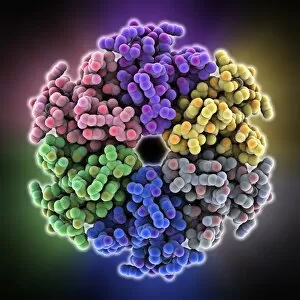Hexameric Collection
"Unveiling the Intricate World Molecules: ATPase, DNA Translocase
All Professionally Made to Order for Quick Shipping
"Unveiling the Intricate World Molecules: ATPase, DNA Translocase, and More" Hexameric molecules are captivating structures that play crucial roles in various biological processes. One such molecule is the ATPase F006/9441, a powerhouse enzyme responsible for energy transfer within cells. Another fascinating member of this family is the DNA translocase, represented by a mesmerizing molecular model. This intricate protein complex facilitates the movement of genetic material during replication or repair processes. Intriguingly, hexameric molecules also contribute to bacterial twitching motility. The bacterial twitching motility protein showcases their ability to enable bacteria to move across surfaces with remarkable precision and efficiency. The significance molecules extends beyond just motion; they also regulate vital cellular functions. The Hemolysin-coregulated protein exemplifies this role as it modulates essential pathways within cells. Moreover, these intriguing structures can be found even in viral proteins like the Simian virus (SV40) large T antigen C015/7069 and C015/7070. These viral hexamers manipulate host cell machinery for their own replication and survival. Not limited to enzymes and viruses alone, hexamerism is also observed in Acyl-CoA hydrolase enzymes C015/6724 and C015/6725. These enzymes play pivotal roles in lipid metabolism by breaking down fatty acid derivatives into usable forms. The study molecules continues to unravel their complexity and importance in diverse biological systems. From energy production to DNA manipulation, from bacterial mobility to viral hijacking – these captivating structures hold immense potential for further exploration and understanding.













